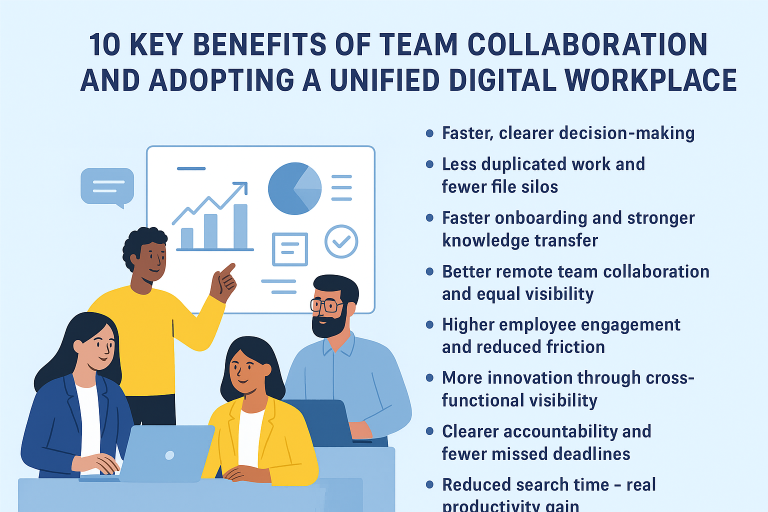Solving Remote Work Challenges with Smarter Team Collaboration

Remote work is no longer an experiment. For many businesses it is the everyday way work gets done. That shift has brought real benefits: more schedule flexibility, access to talent farther afield, and fewer commutes. It has also revealed stubborn problems that show up in quiet ways—missed messages, stalled approvals, and people who feel disconnected even while they are online all day. If you want remote teams to perform like tight, co-located teams, collaboration needs to be smarter, not just digital.
Understanding the real problems remote teams face
Working from different places exposes weak spots in how teams coordinate. These are the issues that keep projects from moving smoothly:
Communication fragments. When conversations live in email, chat, meeting notes, and scattered documents, nobody has a single view of what matters. Messages get missed or misread, and follow-up becomes guesswork. That disconnect is not rare: many workers say remote life erodes the informal glue that keeps teams aligned. owllabs.com
Progress and accountability fade from view. In an office you can spot when someone is stuck and step in. Remotely, it is easy for updates to drift across tools and for blockers to go unseen. That’s why teams that want reliability make sure work and context are visible in the same place.
People feel isolated. Small, casual interactions do far more than fill time. They build trust. Without those touchpoints, engagement drops and it shows in slower decision-making and lower morale.
Time zones and scheduling create friction. Global teams win on talent but pay for it in coordination complexity. Even when people work asynchronously, lack of a single source of truth slows handoffs.
Too many tools become a problem, not a solution. Every new app adds cognitive load and context switching. Instead of saving time, teams lose hours hunting for the right message, file, or meeting note. Studies show collaboration inefficiencies cost real time—many employees report losing multiple hours a week to poor coordination. ProofHub
How smarter collaboration actually changes outcomes
The fix is not trendy features. It is clear processes and a work environment that keeps context, work, and conversation connected. When teams adopt those habits, results are measurable:
Faster, clearer decisions. When conversations stay attached to the work they reference, nobody needs to reconstruct context. Teams spend less time debating and more time delivering.
Fewer missed deadlines. Visibility into who is doing what and when reduces rework. A shared, organized workflow makes it easier to spot bottlenecks and reassign resources quickly.
Higher engagement. When collaboration encourages quick feedback and recognition, people feel noticed. That raises morale and reduces churn.
Greater inclusion and accessibility. When meetings are easier to follow and notes are reliably available, contributors who can’t join live still add value. That widens your talent pool and keeps institutional knowledge intact.
Better productivity at scale. Research shows that organizations that implement thoughtful digital collaboration practices see meaningful productivity gains, often in the range of 20 to 30 percent for collaboration-intensive work. That is not a small uplift—those gains compound across projects and teams. McKinsey & Company
Centralizing context: why it matters more than more apps
Centralizing communication and work into a consistent structure does more than reduce clicks. It reduces cognitive load. Teams get fewer interruptions and spend less time wondering where decisions live. When tasks, conversations, and files are grouped by project and topic, people stop reinventing context and start making progress.
Making asynchronous work reliable is part of that. Asynchronous updates need to arrive in a place where others can find them easily, with clear ownership and status. That lets people collaborate across time zones without waiting for meetings. Over time, the team develops predictable rhythms: who owns daily updates, where approvals happen, and how to escalate blockers. Those patterns are the quiet engine of high-performing remote teams.
How Melp AI Digital Workplace helps teams collaborate efficiently
When a team uses a single, organized workspace, everyday friction disappears. Melp AI Digital Workplace brings conversations, calendars, and work together so people spend less time switching apps and more time moving ideas forward.
That consolidation shows up as cleaner handoffs, faster approvals, and fewer lost threads. Teams report smoother project flow when their chat, meeting notes, and task context live together, rather than scattered across email and separate tools. In short, the platform acts like a shared operating rhythm: people know where to look, how to contribute, and how to find past decisions quickly. owllabs.com+1
Leveraging Melp team collaboration software for daily workflow
Tools matter only when they change behavior. Melp team collaboration software supports routines that reduce friction: clear topic-based conversations, easy access to recent decisions, and straightforward ways to capture what happened in meetings so nobody has to reconstruct it later.
Used this way, teams stop hunting for context and start producing work that moves forward the same day it is discussed. That rhythm—short, regular check-ins, reliable notes, and visible accountability—adds up to fewer delays and happier team members.
Building a culture that makes the tools work
Technology helps, but culture makes it stick. Remote teams should agree on simple norms: where to post updates, how to label priorities, and how to use brief, regular check-ins. Leaders set tone by acknowledging good work, offering quick feedback, and jumping in when patterns show friction.
Train people to use the shared workspace well: teach how to summarize decisions, how to link work to conversation, and how to make asynchronous updates useful. When everyone follows these habits, the platform becomes the team’s memory and the single place to get up to speed.
A practical example
Imagine a marketing team juggling five campaigns. Before standardizing collaboration, team members spent hours each week locating the latest creative, confirming approvals, and clarifying copy changes. After organizing work around clear topics and a single place for updates and approvals, the team shortened review cycles, reduced version errors, and reclaimed hours previously lost to searching and clarifying. That recovery time went straight into improving campaign quality and speed.
The near-term payoff and what to measure
If you want to see whether smarter collaboration is working, track a few simple metrics: time to approval, number of tools in daily use, percentage of meetings that produce actionable notes, and how often people report feeling “in the loop.” Over a few months, you should see fewer stalled tasks, faster cycle times, and steady improvements in engagement.
Remote work will keep evolving. Teams that pair realistic habits with a shared workspace and a commitment to transparency will find the best of both worlds: flexible work and dependable delivery.


